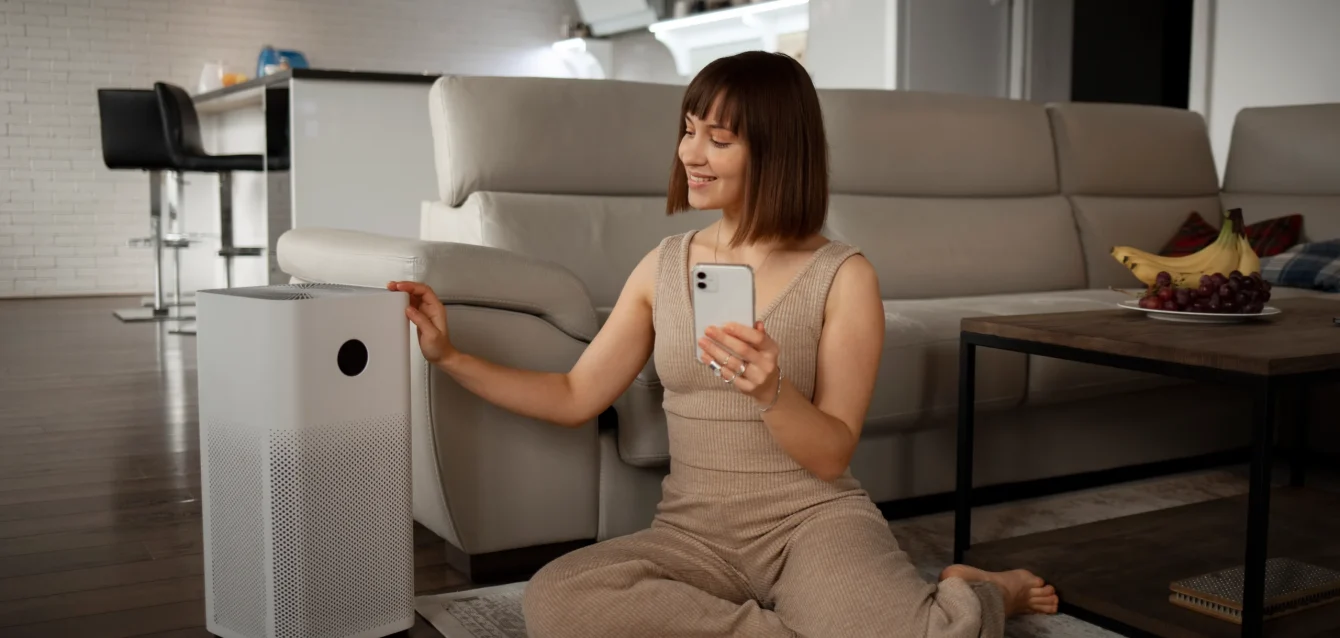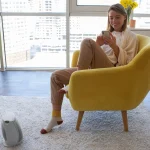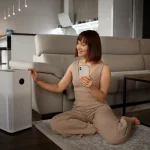
An air purifier makes indoor air cleaner and healthier. It traps dust, allergens, and bad smells. That means easier breathing for you and your family.
If you are a new parent to a newborn, have fur babies, or have someone with allergies at home, you are looking for solutions to provide quality air. But you don’t know how. Then, keep reading this blog to know how BigWater air purifier can solve your clean air problem.
How do air purifiers work?
An air purifier pulls in air from the room.
Then it cleans the air using filters. Most have a fan that sucks air in and pushes it through several layers of filtration.
Here’s how it usually works, step by step:
- The intake fan draws the room air in.
- The pre-filter catches big stuff like hair, lint, or pet fur.
- A HEPA filter traps fine dust, pollen, mold, and other tiny particles.
- Activated carbon filters remove odors, smoke, and VOCs (gases).
- An optional UV light or ionizer kills germs or changes particles so they stick to filters.
- Clean air is released back into the room.
Most machines repeat this cycle multiple times an hour. Some purifiers have smart sensors that adjust their speed based on air quality.
What does an air purifier do?
An air purifier pulls in air from the surrounding environment and removes contaminants before pushing clean air back into the room. It reduces indoor air pollution and makes breathing easier for people and pets.
Here’s what an air purifier typically targets and how it helps:
- Dust: Removes fine particles that settle on furniture and irritate the lungs.
- Pollen: Helpful during allergy seasons, reducing sneezing and watery eyes.
- Pet dander: Captures tiny skin flakes from cats, dogs, or other pets that can trigger allergic reactions.
- Mold spores: Traps mold particles floating in the air to reduce health risks and musty smells.
- Smoke and odors: Activated carbon filters absorb smoke, cooking smells, and chemical fumes from cleaners or paint.
- Germs and bacteria: Some purifiers come with UV or ionizing technology that kills or neutralizes bacteria and viruses.
These functions make air purifiers useful in homes, offices, classrooms, and any indoor space where clean air is a priority. They’re especially helpful for children, older adults, and people with asthma or allergies.
An air purifier removes stuff you don’t want to breathe in. That includes:
● Dust
● Pollen
● Mold spores
● Pet dander
● Smoke
● Bacteria
● Cooking smells
● Chemicals in paint or cleaners
They can’t be seen with the naked eye, but they affect breathing, sleep, and health.
Some people use them for allergies, while others want fresher air at home. If you live near a busy road or wildfire area, a purifier helps even more.
Depending on what you need to clean, you can use them in bedrooms, nurseries, living rooms, or offices.
Air purifier vs. humidifier
These two devices serve very different functions, though both are used indoors. A humidifier adds moisture to the air. It’s helpful when the environment is dry, like during winter or in desert climates. It prevents dry skin, irritated throats, and static electricity.
On the contrary, an air purifier removes airborne particles and allergens like dust, smoke, pollen, and dander. It makes the air cleaner but does not change humidity levels.
| Feature | What an Air Purifier Does | What a Humidifier Does |
| Main Function | Removes airborne pollutants | Adds moisture to dry air |
| Helps With | Allergies, asthma, odors | Dry skin, dry throat, nosebleeds |
| Output | Clean, filtered air | Moist, humidified air |
| Use Case | Polluted or dusty environments | Dry indoor air or winter seasons |
You can use both an air purifier and a humidifier in the same space/air. But just keep them a few feet apart so they don’t affect each other’s performance.
A humidifier adds moisture to dry air, which is helpful in winter or dry places. An air purifier clears the air and removes particles.
Air purifier vs. dehumidifier
A dehumidifier pulls excess moisture from the air. It prevents mold, mildew, and that musty smell in damp rooms. An air purifier, on the other hand, captures airborne particles and allergens but does not affect humidity levels.
| Feature | What an Air Purifier Does | What a Dehumidifier Does |
| Main Function | Cleans the air by removing particles | Removes humidity from the air |
| Helps With | Allergies, asthma, odors | Mold, dampness, and mildew prevention |
| Output | Filtered, clean air | Dry, dehumidified air |
| Use Case | Homes with pollution, smoke, or pets | Basements, bathrooms, or humid climates |
In some situations, using both devices can create a healthier indoor environment, especially in humid but dusty rooms.
A dehumidifier pulls moisture out of the air to help prevent mold and damp smells. An air purifier traps particles, but it doesn’t deal with humidity.
Air purifier vs. air filter
An air filter is a single part of a system, as it can be found in your AC, furnace, or purifier.
While an air purifier is a complete machine, it uses multiple filters, fans, and extras like carbon or UV.
Think of it like this:
● An air filter is like a sponge.
● An air purifier is a full cleaning tool.
You change the air filter in your HVAC every few months. A purifier runs on its own. It’s more targeted and works in rooms that need extra help.
Do air purifiers really work?
Yes. They work best in closed rooms, so keep doors and windows closed. Also, make sure it fits your room size, and keep an eye on the CADR (Clean Air Delivery Rate). Bigger spaces need stronger units.
Scientific tests confirm that HEPA purifiers remove over 99% of particles down to 0.3 microns, including most common allergens.
Real users report fewer sneezes, better sleep, and less dust on furniture. It’s not magic—but it’s real science.
Are air purifiers worth it?
Yes, if you care about breathing in clean air, get quality air purifiers like Jupiter. An air purifier is worth the cost!
It supports your health in many ways, such as
● Allergies
● Asthma
● Respiratory issues
● Pets
● Kids or babies
● Seniors at home
If you live in close apartments, it can also protect you during wildfire season or construction nearby. Air purifier maintenance is simple; make sure to change the filters on time. It’s low effort with a high return.
Benefits of air purifiers
The benefits of air purifiers are countless, but the major ones are mentioned below:
● Cleaner air helps with easier breathing
● Less dust and fewer allergens
● Fewer asthma or allergy triggers
● Neutralizes odors
● Improves sleep
● Reduces airborne viruses and bacteria
● Supports the immune system
A 2021 EPA report confirmed that indoor air is often 2–5x more polluted than outside. An air purifier helps fix that, especially in places with poor ventilation or lots of indoor activity.
Are air purifiers good for newborns?
Yes, an air purifier can be beneficial in a baby’s room. Newborns have developing lungs and sensitive immune systems, which make them prone to diseases. Clean air supports their breathing and reduces exposure to allergens, dust, and potential germs.
Air purifiers with HEPA filters are ideal. They capture small particles without releasing anything harmful into the air. Avoid purifiers that use ozone or strong ionizing features, as they can irritate tiny lungs.
Place the purifier a few feet away from the crib and keep it on a quiet, low setting. To create a calm and safe sleeping space for your baby.
Are air purifiers safe for pets?
Yes. Most air purifiers are safe for pets.
In fact, pets benefit the most because fur and dander float in the air. Purifiers remove those particles. It also allows you to know if you’re allergic to your cat or dog.
Avoid ionizers that release ozone. Stick with HEPA and carbon-based models. Place the air purifier machines away from pet beds or food bowls, but place them where they relax.
Conclusion
An air purifier can make a big difference in your everyday health and comfort. From filtering out allergens and dust to eliminating odors and bacteria, it’s a tool that helps you breathe easier and feel better.
Whether you live in a city apartment, a house with pets, or a space with poor airflow, using the right purifier can reduce the risk of airborne issues and improve your overall well-being.
It’s simple to use and easy to maintain. Just pick the right model for your room size and remember to change the filters on time.For trusted, tested options, contact BigWater to breathe quality air!




